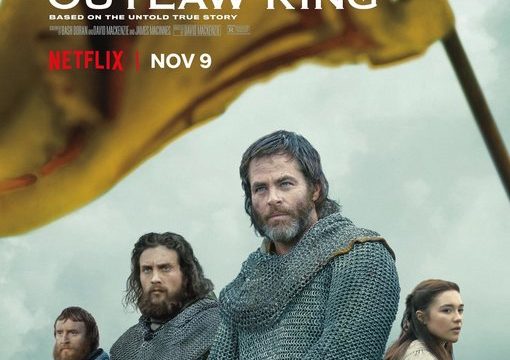The Hollywood epic was a common sight in the 1950’s and 1960’s as Hollywood tried to combat the rise of television programming with a horde of movies that used gargantuan budgets to bring to life massive-in-scale stories that usually took place in ancient periods of history. How funny then to consider that the newest Netflix original movie Outlaw King, which reunites director David Mackenzie with his Hell or High Water leading man Chris Pine, is an obvious homage to those types of movies, complete with a $120 million budget that makes it the most expensive Netflix movie yet (Martin Scorsese’s The Irishman is waiting in the wings for its chance to turn to Outlaw King and say “Hold my beer!”), yet it’ll be seen by the vast majority of people on…televisions!
Putting aside that odd bit of irony, let’s look at the story of Outlaw King, which chronicles the true historical ascent of Robert the Bruce (Chris Pine) leading a revolution against King Edward I of England to take back Scotland from this ruthless tyrant who bleeds the pockets of the citizens for his taxes and forces their children to fight in his Wars. Robert is faced with immediate powerful opposition to his attempt to take back the Crown and now the King has sent all his most powerful men, including his son Edward (Billy Howle), to stop Robert and his ragtag group of Scottish rebels who are willing to do anything to back their country.
Unlike many modern-day blockbusters like Gods of Egypt or The Mummy that spend ungodly amounts of money only to look like they were made on the cheap, Outlaw King tells this true story in a fashion that clearly makes good use of every penny in its budget. Countless elaborate sets and intricately detailed costumes recreating the look and feel of the early 14th century abound throughout the story while the battle scenes are clearly making use of both real extras and real environments that lend a welcome tangibility to these sequences of immense bloodshed. All of the money poured into this project comes through in the best visual elements of the production which are impeccably realized.
Unfortunately, all of that expensive splendor is used on a screenplay (credited to five writers, including David Mackenzie) that’s pretty bog-standard, particularly when it comes to its forgettable characters. We’ve had recent historical dramas like Colette and First Man that do an excellent job making recognizable human being outs of noteworthy historical figures but Outlaw King struggles with making Robert the Bruce and especially any of the characters surrounding him feel like people. Early on in the story, one character remarks to Robert the Bruce that William Wallace was more of an idea than a person and that’s also how Outlaw King treats its lead character. This take on Robert the Bruce just acts like a polished stoic leader the moment he starts contemplating a revolution and he doesn’t become any more of a person from there, he just becomes a mechanism to deliver banal dialogue about fighting for freedom and Scotland.
The underwritten nature of this role is especially a shame given that Chris Pine is trying his hardest in this role, including his solid work in doing a Scottish accent. Pine works best when he has a clearly defined outsized personality to work with in films like Stretch, Into the Woods or Wonder Woman but his quietly remarkable performance in Hell or High Water showed he can also play normal people extremely well, what a pity he rarely gets to use that talent here. The rest of the cast, particularly the interchangeable close allies of Robert the Bruce (which include Aaron Taylor-Johnson as a character who’s off on his own separate revenge thriller story), mostly fade into the background save for Florence Pugh as the protagonist’s wife, Elizabeth de Burgh, she actually registers as the most discernably human character in the whole movie thanks to her more emotionally varied performance.
Just as nickels make dimes, the generic characters of Outlaw King make for a generic story, one that presents these historical events through the prism of a David-and-Goliath revenge story that feels too derivative of other movies like Gladiator (and that Ridley Scott epic was itself already suffering from a lack of originality!) while the tone and visual aesthetic feel like they could have come from any number of medieval-set movies released in the last ten years. Perhaps most tragically, the aforementioned lack of vibrant characters also hinders the handful of massive battle sequences, which are difficult to invest in despite all of the effort that’s clearly going into bringing them to life. All of the extended shots of Scots slitting the throats of their enemies just can’t add up to much if those Scottish characters aren’t properly fleshed out as people.
At least the script makes the wise decision to eschew one fixture of the Hollywood epic, a three-hour-plus runtime, in favor of a runtime just under two hours that at least allow this frequently uninspired story to move at a reasonable clip. Meanwhile, in the director’s chair, David Mackenzie seems to be relishing having such a larger canvas to play with if the elaborate camerawork that includes numerous sprawling wide shots of the Scottish landscape and numerous instances of sporadically successful extended single takes is anything to go by. A lot of effort was clearly put into Outlaw King and that comes through in certain areas, but the rote screenplay and the weakly written characters within are like a cement block tied to this movies feet that’s just dragging it down constantly. The spectacle of what it’s like fighting for Scotland is captured in Outlaw King but since the film struggles to also capture the humanity of that fight, such spectacle feels far emptier than it should.

